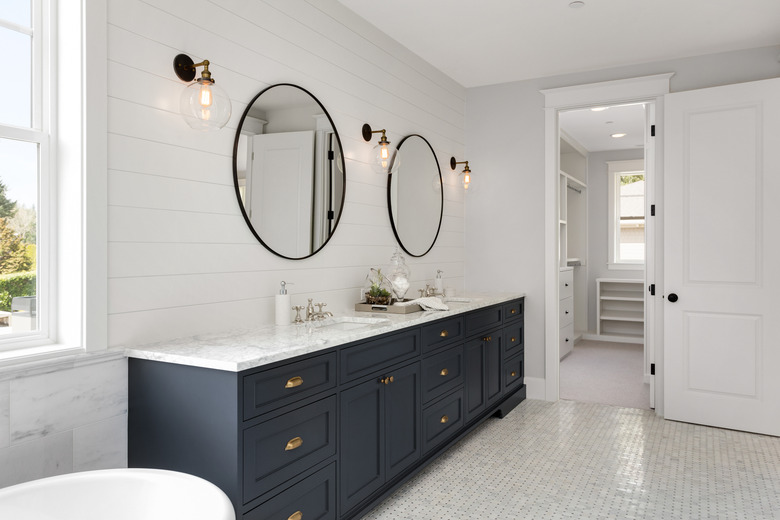How To Make A Bathroom Door Swing Out
We may receive a commission on purchases made from links.
An in-swing door can take up a lot of space in a bathroom, and circumstances such as a newly handicapped family member may necessitate changing the direction the door swings to make it easier to move around in there. There is no code issue except in one case: If the bathroom is at the top of a staircase, the door must swing into the bathroom to avoid interfering with people using the stairs. In all other cases, changing the direction of the door swing is legal.
You'll have to take the door down to make the change, and as long as you're doing that, you may decide to change the handing — that is, putting the hinges on the opposite side of the jamb. You can reverse the swing direction without reversing the handing, but if you change the handing, you don't have to modify the hinges on the door or change the doorknob direction, so it's a slightly easier procedure.
Things Needed
-
Screwdriver
-
1/4-inch wood stock
-
Orbital sander
-
Shims
-
Pencil
-
Epoxy putty
-
Hammer and chisel
-
Finish nails
-
Lipstick
-
Drill
How to Make a Bathroom Door Swing Out
1. Take Down the Door
Close the door, pull the hinge pins, and then open the door and let it fall into your hands. Unscrew and remove the hinges from the doorjamb, remove the strike plate from the opposite jamb, and remove the door stops with a small pry bar. Pry carefully to keep the stops intact so you can reuse them.
2. Fill the Hinge and Strike Mortises
Cut pieces of 1/4-inch wood stock to fit into the hinge mortises and glue them in place with contact cement. Cover the mortise for the strike — including the hole for the latch barrel — in the same way. Fill gaps around these patches with epoxy wood filler and then sand the wood flat with an orbital sander. You'll need to repaint these patches, but you can do this after rehanging the door.
3. Make Marks for New Hinge Mortises
The best way to accurately mark hinge mortises on a doorjamb is to reattach the hinge leaves to the ones on the door, set the door back in the jamb, prop it up on shims to close the gap at the top, and leave a space underneath the door. Then unfold the hinges against the jamb and draw their outlines with a pencil.
If you aren't reversing the handing of the door, meaning the hinges are on the same side of the jamb, you must reverse the direction of the hinges on the door before you do this. Unscrew them, turn them in the opposite direction, reset them with the pin barrels flush against the other side of the door, and screw them back to the door. The screw holes probably won't overlap any of the existing ones, but if they do, fill the existing holes with epoxy putty and let the putty set before driving new screws.
4. Chisel or Rout the Hinge Mortises
Make the mortises deep enough for the surfaces of the hinges to be flush with the jamb. You can do this with a hammer and chisel, but a small router with a straight cutting bit set to the exact depth you need does a neater job.
5. Hang the Door
Set the door back in place, shim it up, and unfold the hinges into the mortises. Screw the hinges to the doorjamb with the same screws that were holding it before. Remove the shims and then open and close the door to be sure it swings freely and closes without sticking.
6. Replace the Door Stop
Close the door all the way so that the outside surface is flush with the edge of the jamb. Position the door stops against the inside edges of the closed door and nail them to the jamb with finish nails.
7. Reverse the Doorknob
If you didn't change the handing, you have to remove the knob from the door, turn it around, and install it in the opposite direction. If you did change the handing, this won't be necessary because the knob is already facing in the right direction.
8. Install the Strike Plate
Mark the position of the latch barrel on the jamb when the door is fully closed. An easy way to do this is to put lipstick on the end of the barrel and let it make a mark on the jamb. Drill a 1-inch hole on the mark that is about 3/4 inch deep. Center the strike plate on the hole, trace its outline, and chisel inside the outline to make a mortise for the plate. Screw the strike plate to the jamb and then close the door and make sure the latch fully engages.
